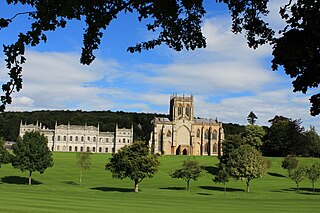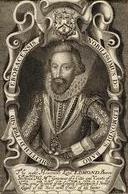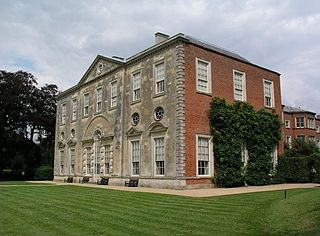
Milton Abbey school is an independent school for day and boarding pupils in the village of Milton Abbas, near Blandford Forum in Dorset, in South West England. It has 224 pupils as of September 2019, in five houses: Athelstan, Damer, Hambro, Hodgkinson and Tregonwell. The school was founded in 1954 and is co-educational.

Marquess of Normanby is a title that has been created twice, once in the Peerage of England and once in the Peerage of the United Kingdom. The first creation came in 1694 in the Peerage of England in favour of John Sheffield, 3rd Earl of Mulgrave. He was a notable Tory politician of the late Stuart period, who served under Queen Anne as Lord Privy Seal and Lord President of the Council. In 1703 this first Marquess of Normanby was further honoured when he was made Duke of Buckingham and Normanby. These titles became extinct on the death of the 2nd Duke in 1735.

Marquess Conyngham, of the County of Donegal, is a title in the Peerage of Ireland. It was created in 1816 for Henry Conyngham, 1st Earl Conyngham. He was the great-nephew of another Henry Conyngham, 1st Earl Conyngham, a member of a family of Scottish descent which had settled during the Plantation of Ulster in County Donegal in Ireland in the early 17th century. The 'founder' of the dynasty in Ireland was The Very Rev. Dr. Alexander Cunningham, Dean of Raphoe. The earlier Henry was a member of both the Irish House of Commons and the British House of Commons and served as Vice-Admiral of Ulster and as Governor of the counties of Donegal and Londonderry. In 1753 he was raised to the Peerage of Ireland as Baron Conyngham, of Mount Charles in the County of Donegal, and in 1756 he was created Viscount Conyngham, in Ireland, also in the Peerage of Ireland. In 1781 he was made Baron Conyngham, of Mount Charles in the County of Donegal, with remainder to his nephew Francis Burton, and Earl Conyngham, of Mount Charles in the County of Donegal, which like the creations of 1753 and 1756 was created with normal remainder to the heirs male of his body. The latter titles were also in the Peerage of Ireland. Lord Conyngham was childless and on his death in 1781 the barony of 1753, the viscountcy and earldom became extinct while he was succeeded in the barony of 1781 according to the special remainder by his aforementioned nephew Francis. He was the eldest son of Mary, sister of the first Earl Conyngham, by her husband Francis Burton. The new 2nd Baron Conyngham, who had earlier represented Killybegs and County Clare in the Irish House of Commons, assumed by Royal licence the surname and arms of Conyngham on succeeding to the titles.

Marquess of Ailsa, of the Isle of Ailsa in the County of Ayr, is a title in the Peerage of the United Kingdom. It was created on 10 September 1831 for Archibald Kennedy, 12th Earl of Cassilis. The title Earl of Cassilis had been created in 1509 for the 3rd Lord Kennedy. This title had been created in the Peerage of Scotland in 1457. The 1st Marquess had been created Baron Ailsa in the Peerage of the United Kingdom on 12 November 1806.

General Henry Phipps, 1st Earl of Mulgrave,, styled The Honourable Henry Phipps until 1792 and known as The Lord Mulgrave from 1792 to 1812, was a British soldier and politician. He notably served as Foreign Secretary under William Pitt the Younger from 1805 to 1806.

The title Earl of Mulgrave has been created twice. The first time as a title in the Peerage of England and the second time as a Peerage of the United Kingdom.

Earl of Portarlington is a title in the Peerage of Ireland. It was created in 1785 for John Dawson, 1st Earl of Portarlington, who had earlier represented Portarlington in the Irish House of Commons. He was the son of William Dawson, 1st Viscount Carlow, who had represented Portarlington and Queen's County in the Irish House of Commons, and had been created Baron Dawson, of Dawson's Court in the Queen's County, in 1770, and Viscount Carlow, in the County of Carlow, in 1776. These titles were also in the Peerage of Ireland. The first Earl was succeeded by his eldest son, the second Earl. He was a Colonel in the 23rd Light Dragoons but disappeared the night before the Battle of Waterloo and thus missed the start of the battle. He then attached himself to the 18th Hussars, but after the battle was forced to resign his commission in disgrace, fell into dissipation and 'died in an obscure London slum'.
Joseph Damer, 1st Earl of Dorchester was a country landowner and politician who sat in the House of Commons from 1741 to 1762 when he was raised to the peerage as Baron Milton. He was particularly associated with the reshaping of Milton Abbey and the creation of the village of Milton Abbas in Dorset, south-west England.

Marquess of Hastings was a title in the Peerage of the United Kingdom. It was created on 6 December 1816 for Francis Rawdon-Hastings, 2nd Earl of Moira.

Catherine Sedley, Countess of Dorchester, Countess of Portmore, daughter of Sir Charles Sedley, 5th Baronet, was the mistress of King James II and VII both before and after he came to the throne. Catherine was noted not for beauty but for her celebrated wittiness and sharp tongue.

Earl Cornwallis was a title in the Peerage of Great Britain. It was created in 1753 for Charles Cornwallis, 5th Baron Cornwallis. The second Earl was created Marquess Cornwallis but this title became extinct in 1823, while the earldom and its subsidiary titles became extinct in 1852. The Cornwallis family descended from Frederick Cornwallis, who represented Eye and Ipswich in the House of Commons. He was created a Baronet in the Baronetage of England in 1627 and Baron Cornwallis, of Eye in the County of Suffolk, in the Peerage of England in 1661. He was succeeded by his son, the second Baron, who also sat as Member of Parliament for Eye. On his death the titles passed to his son, the third Baron. He notably served as First Lord of the Admiralty. His son, the fourth Baron, was Lord Lieutenant of Suffolk and Postmaster General.
The titles of Baron Milton and Viscount Milton have both been created several times.

Sir Murrough O'Brien, 10th Baron of Inchiquin, 5th Baron O'Brien of Burren, 1st Baron Thomond of Taplow, 5th Earl of Inchiquin, 1st Marquess of Thomond KP, PC (Ire), known from 1777 to 1800 as the 5th Earl of Inchiquin, was an Irish peer, soldier and politician.

Baron Dorchester was a title that was created twice in British history, once in the Peerage of Great Britain and once in the Peerage of the United Kingdom. The first creation came in the Peerage of Great Britain on 21 August 1786 when the soldier and administrator Sir Guy Carleton was made Lord Dorchester, Baron of Dorchester, in the County of Oxford. He was succeeded by his grandson, the second Baron. He was the son of the Hon. Christopher Carleton, eldest son of the first Baron. Lord Dorchester died unmarried at an early age and was succeeded by his first cousin, the third Baron. He was the son of the Hon. George Carleton, younger son of the first Baron. He had no sons and was succeeded by his first cousin, the fourth Baron. He was the son of Reverend the Hon. Richard Carleton, younger son of the first Baron. Lord Dorchester was a Colonel in the Coldstream Guards. He was childless and the title became extinct on his death on 13 November 1897.

Earl Verney, in the Province of Leinster, was a title in the Peerage of Ireland. Sir Ralph Verney sat as a Member of Parliament for Aylesbury, for Great Bedwyn and for Buckingham. In 1661 he was created a Baronet, of Middle Claydon in the County of Buckingham, in the Baronetage of England. His son Sir John Verney, Bt, was a Member of Parliament for Buckinghamshire and for Amersham. In 1703, he was raised to the Peerage of Ireland as Baron Verney of Belturbet, in the County of Cavan, and Viscount Fermanagh. His son, the second Viscount, represented Amersham and Wendover in Parliament. In 1742 he was created Earl Verney, in the Province of Leinster, in the Peerage of Ireland. However, all titles became extinct on the death of his son, the second Earl, in 1791.
Lord Milton may refer to:

George Damer, 2nd Earl of Dorchester, PC, PC (Ire), styled Viscount Milton between 1792 and 1798, was a British politician. He served as Chief Secretary for Ireland between 1794 and 1795.
Constantine Phipps, 1st Baron Mulgrave was an Irish peer. In 1767 he was created Baron Mulgrave, of New Ross in the County of Wexford, in the Peerage of Ireland.
Charles Cornwallis, 1st Earl Cornwallis, styled The Honourable Charles Cornwallis until 1722 and known as The Lord Cornwallis between 1722 and 1753, was a British peer.











